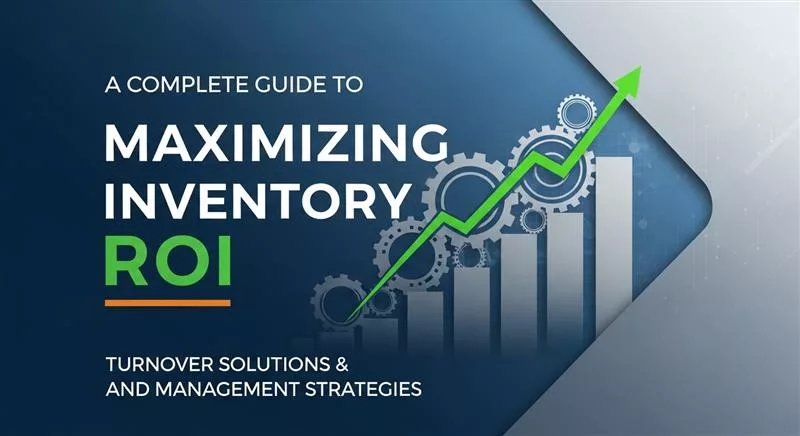Estimated reading time: 8 minutes
Running a successful convenience store or gas station is more complex than just pumping gas and stocking snacks. True profitability, the kind that keeps the lights on and allows for expansion, hinges on one critical, often overlooked area: inventory. Specifically, how fast and how smart you move product off the shelves. That’s why we’re diving deep into inventory turnover management, a key practice for any cstore owner looking to fundamentally improve their bottom line. The goal isn’t simply to sell more stuff; it’s to maximize your ROI on inventory by ensuring every dollar invested in product is working its hardest for the shortest amount of time possible.
Understanding ROI on Inventory and the Role of Turnover
Return on Investment (ROI) in the context of your store’s stock is pretty simple: it’s the profit generated from your investment in inventory, relative to the cost of that inventory. If you buy a case of soda for twenty dollars and sell it for thirty, your profit is ten dollars. But turnover, which is the number of times you sell and replace your average inventory level over a period, is the engine that drives that ROI. A slow turnover rate means cash is tied up in product sitting on a shelf, unable to be reinvested. A fast, efficient turnover, conversely, frees up capital quicker, allowing that money to be used to purchase new, high-demand items, or pay down debt. Essentially, faster turnover equals better cash flow, and improved cash flow, that’s just good business for a small operation like yours. Getting the balance right is the trick, and it’s something that often separates the thriving cstores from the just-getting-by ones.
Common Challenges in Inventory Turnover
Every cstore operator faces a set of predictable, persistent headaches when it comes to inventory. Overstocking is a drain; it absorbs capital that could be used elsewhere, takes up valuable storage space, and increases the risk of spoilage or obsolescence. Think of the holiday candy still sitting there in February-that’s money just gathering dust. Conversely, stockouts are direct hits to profit and customer loyalty. A customer walks in specifically for a particular energy drink, and if it’s not there, they might go next door. NACS data consistently show that a significant portion of cstore sales are impulse buys, so having the right product on the shelf at all times is incredibly important for capturing those sales, and when you’re out, you miss that opportunity. These issues are often symptoms of poor demand forecasting, which is trying to guess what people want without reliable data. Also, let’s not forget shrinkage, which includes theft and operational errors, directly reducing the quantity of sellable goods and skewing inventory counts, which complicates reordering. Finally, inefficient purchasing practices, such as buying based on guesswork or tradition instead of real time sales data, compound all these problems, leading to cycles of over and understocking.
Did you know that the average time a person spends looking at a billboard while driving sixty miles per hour is only about three seconds? It’s completely unrelated to inventory, but I just read that somewhere and found it interesting, you know? Back to inventory, fixing these challenges requires a shift from manual, reactive management to systematic, data-driven solutions. That means getting serious about how you track everything.
How POS Systems, Price Books, and Inventory Management Software Improve Turnover
The secret to mastering turnover isn’t more elbow grease; it’s better technology. Modern POS systems and inventory software are not just tools for ringing up sales. They are your primary engines for data collection and analysis. A robust POS tracks every single sale in real time. This immediate, accurate data is the backbone of efficient turnover. By analyzing sales velocity-how fast an item moves-the system can inform highly precise reorder points, eliminating the guesswork that leads to overstocking and stockouts. This precision is essential. According to the National Retail Federation (NRF), inventory accuracy is a top priority for retailers seeking to improve efficiency and reduce loss, meaning cstores aren’t unique in needing better tools. Petrosoft’s CStoreOffice back-office solution is built specifically to address these challenges. It integrates sales data directly from your POS (like the SmartPOS system) to provide centralized inventory management. It utilizes Artificial Intelligence to automatically generate orders based on sales data, which is crucial for moving away from guessing and into data-driven replenishment.
Furthermore, a well maintained price book management system ensures the item files, costs, and pricing are accurate across the entire store, reducing checkout errors and improving margin tracking, which is crucial for calculating accurate ROI. The CStoreOffice system offers robust, centralized price book management, allowing you to update prices globally or by location quickly. They even offer Price Book Enrichment features that pull item information from the world’s largest UPC database, cleaning up your data and ensuring no mislabeled SKUs are throwing off your inventory counts. When integrated with inventory management software, these systems begin to automate the tedious and error-prone parts of the job. The software scrutinizes the data, identifies slow movers that need to be discounted, and alerts you to fast movers that require expedited reordering. This holistic approach makes inventory turnover solutions not just a luxury, but a necessity for maximizing profits in a competitive market. Implementing this technology helps store owners move away from the traditional clipboard and pencil method and into a streamlined, analytical process that naturally boosts turnover.
Benefits of Effective Inventory Turnover Management for ROI
When you effectively manage inventory turnover, the benefits cascade across your entire operation, directly boosting your ROI. The most obvious gain is an improved cash flow. Money that was previously tied up in a back room is now freed to be used for strategic investments, like store upgrades or marketing initiatives. This is a game changer for smaller businesses where working capital is often tight, giving the operator an important advantage. Petrosoft’s Retail360 mobile app and CStoreOffice platform give you real-time visibility into shrink and sales velocity, helping to reduce losses and providing the necessary data for faster inventory turns. Petrosoft customers have reported metrics like a 1.5X faster inventory turn rate which shows the direct impact of using a robust, cloud-based system. Additionally, faster turnover translates to fresher products, particularly important for high-margin categories like food service and prepared foods, which is a growing area for cstores as noted by NACS reports. Nobody wants stale coffee or old sandwiches. Improved freshness enhances the customer experience, leading to repeat business and greater transaction size, which is a subtle but powerful driver of overall profit. Because your ordering is based on actual demand, the risk of having to markdown items due to obsolescence or expiry is significantly reduced, which directly protects your gross margin. It’s a complete cycle where better information leads to better decisions, those decisions lead to faster sales, and faster sales lead to better returns on every product dollar invested.
Conclusion
Mastering how to manage inventory effectively is not a one-time fix but an ongoing, tech-driven process that should be at the core of your store’s operation. By adopting integrated POS, price book, and inventory management software, cstore and gas station owners can transform their approach from reactive to predictive. Petrosoft’s ecosystem, centered on CStoreOffice, provides the complete suite of inventory turnover solutions you need-from a centralized, enriched price book to automated purchasing recommendations. This methodical application of inventory turnover management principles is the clearest path to fundamentally better cash flow, reduced waste, and a substantially higher ROI on inventory. It’s time to stop letting money sit on the shelves and start making every dollar earn its keep.
Frequently Asked Questions (FAQ) for C-Store Owners
1. What is the single most important metric I should track to start improving my inventory ROI?
The single most important metric is Inventory Turnover Rate (ITR), which is calculated as Cost of Goods Sold ÷ Average Inventory. Track this number by category (e.g., beverages, snacks, tobacco). A high ITR means items are selling fast, freeing up cash. A sudden drop in a category’s ITR is an immediate red flag for overstocking or low demand.
2. How do I deal with slow-moving inventory that is tying up my capital?
First, identify it using your POS data-anything with an ITR significantly lower than the category average. Your options are to discount and promote immediately (e.g., ‘buy one, get one free’ to clear it out and recover some cash), bundle it with faster-moving items, or, if it’s perishable and about to expire, donate it (and track the loss for tax purposes). Don’t let it sit; the cost of holding it is higher than taking a small loss to recover capital.
3. What is the biggest mistake c-store owners make with their Price Book?
The biggest mistake is failing to maintain it daily, which includes neglecting cost changes from suppliers, not updating promotional prices, and not linking new items accurately to the correct department/category. An inaccurate price book leads to incorrect margins at the register and flawed demand forecasting in your inventory software, undermining all your efforts to track ROI. Petrosoft’s Price Book Enrichment service can clean and standardize this data for you, making ongoing maintenance much easier.
4. My store is too small to afford a full inventory management system. What’s my first step?
Start by maximizing the utility of the technology you likely already have: your Point-of-Sale (POS) system. Ensure every sale is scanned correctly to capture accurate sales data. Use the basic reporting features to track daily sales by item. Even a basic POS can provide the data needed to manually calculate your top 20 best-selling items, allowing you to prioritize accurate ordering for that core group, which likely drives 80% of your sales. Petrosoft’s SmartPOS and CStoreOffice are designed to be scalable and cloud-based, offering an integrated starting point that grows with your business without needing huge upfront infrastructure costs.
5. How often should I be physically counting my inventory?
While integrated software minimizes the need for full physical counts, you should be performing cycle counts (counting a small selection of items) daily or weekly to check the accuracy of your system, especially for high-value items (like tobacco) or high-shrink items. A complete physical inventory count should be done at least quarterly or semiannually to ensure the inventory value on your balance sheet is accurate and to catch any significant variances the system missed. You can use Petrosoft’s Retail360 mobile app to perform these counts and check SKUs right from your smartphone, eliminating the need for paper and speeding up reconciliation with the back-office system.


